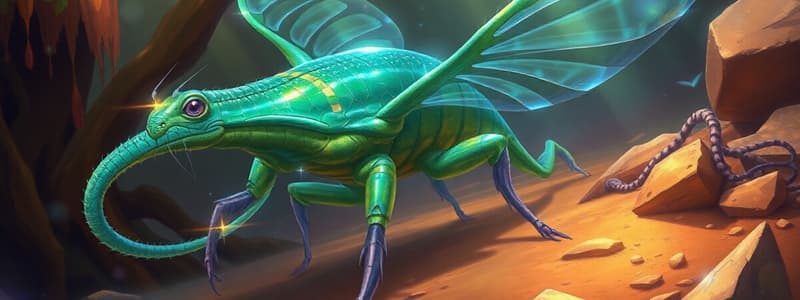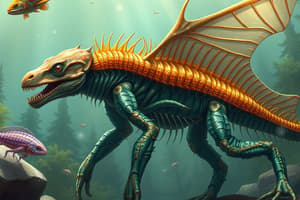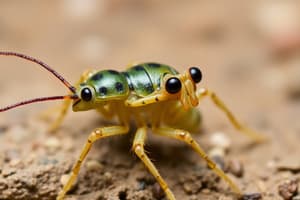Podcast
Questions and Answers
Which of the following is true about Cyclostomes?
Which of the following is true about Cyclostomes?
- They have jaws.
- They possess a bony skeleton.
- They are known for their mineralized skeleton.
- They have a circular mouth. (correct)
Gnathostomes evolved from vertebrates through the modification of gill arches.
Gnathostomes evolved from vertebrates through the modification of gill arches.
True (A)
What is the primary feature that distinguishes Chondrichthyes from bony fish?
What is the primary feature that distinguishes Chondrichthyes from bony fish?
Cartilaginous skeleton
Cyclostomes consist of vertebrates without ______.
Cyclostomes consist of vertebrates without ______.
Match the group of vertebrates with their characteristic features:
Match the group of vertebrates with their characteristic features:
What is a defining characteristic of invertebrates?
What is a defining characteristic of invertebrates?
The Ctenophora phylum is characterized by being triploblastic with bilateral symmetry.
The Ctenophora phylum is characterized by being triploblastic with bilateral symmetry.
What evolutionary significance does the notochord hold for vertebrates?
What evolutionary significance does the notochord hold for vertebrates?
Ctenophores are characterized by having a ________ nervous system.
Ctenophores are characterized by having a ________ nervous system.
Match the following phyla with their characteristics:
Match the following phyla with their characteristics:
Which characteristic is typical of Cnidaria?
Which characteristic is typical of Cnidaria?
Which of the following groups includes organisms that are primarily sessile?
Which of the following groups includes organisms that are primarily sessile?
Protostomic animals possess a digestive tract.
Protostomic animals possess a digestive tract.
All tetrapods are classified under the clade Chordata.
All tetrapods are classified under the clade Chordata.
Name one adaptation that allowed early tetrapods to colonize land.
Name one adaptation that allowed early tetrapods to colonize land.
What is the evolutionary significance of bilateral symmetry in animals?
What is the evolutionary significance of bilateral symmetry in animals?
Echinodermata display _______ symmetry and are classified as deuterostomes.
Echinodermata display _______ symmetry and are classified as deuterostomes.
Match the following protostomic features with their corresponding groups:
Match the following protostomic features with their corresponding groups:
What is the role of a lophophore in protostomic animals?
What is the role of a lophophore in protostomic animals?
All arthropods possess a rigid exoskeleton made solely of chitin.
All arthropods possess a rigid exoskeleton made solely of chitin.
The ___________ is a crucial feature of chordates, providing support and attachment for muscles.
The ___________ is a crucial feature of chordates, providing support and attachment for muscles.
Which of the following adaptations were necessary for colonization of land?
Which of the following adaptations were necessary for colonization of land?
Tiktaalik is considered to be a fossil that shows both fish and amphibian traits.
Tiktaalik is considered to be a fossil that shows both fish and amphibian traits.
Which of the following is NOT a mode of reproduction in Chondrichthyes?
Which of the following is NOT a mode of reproduction in Chondrichthyes?
What are the four embryonic membranes of amniotes?
What are the four embryonic membranes of amniotes?
Osteichthyes possess an internal skeleton.
Osteichthyes possess an internal skeleton.
Amphibians undergo __________ during their life cycle, involving a transition from aquatic larvae to terrestrial adults.
Amphibians undergo __________ during their life cycle, involving a transition from aquatic larvae to terrestrial adults.
What type of environment did early lobed-finned bony fish (Sarcopterygii) inhabit?
What type of environment did early lobed-finned bony fish (Sarcopterygii) inhabit?
Cyclostomes are homologous to vertebrate teeth made of __________ and enamel.
Cyclostomes are homologous to vertebrate teeth made of __________ and enamel.
Match the following groups of amphibians with their classifications:
Match the following groups of amphibians with their classifications:
Which characteristic is true for reptiles?
Which characteristic is true for reptiles?
Match the following groups of fish to their characteristics:
Match the following groups of fish to their characteristics:
Birds are classified as mammals due to their unique characteristics.
Birds are classified as mammals due to their unique characteristics.
What adaptation do Dipnoi (lungfish) have that is homologous to tetrapod lungs?
What adaptation do Dipnoi (lungfish) have that is homologous to tetrapod lungs?
What is an exaptation in the context of bird feathers?
What is an exaptation in the context of bird feathers?
Most bony fish are ovoviviparous.
Most bony fish are ovoviviparous.
What term refers to the ability of some organisms to resist dry conditions, often by burrowing into mud?
What term refers to the ability of some organisms to resist dry conditions, often by burrowing into mud?
Which of the following characteristics is NOT associated with Archaeopteryx?
Which of the following characteristics is NOT associated with Archaeopteryx?
All mammals have mammary glands.
All mammals have mammary glands.
What is the primary advantage of having an opposable thumb in primates?
What is the primary advantage of having an opposable thumb in primates?
Humans belong to the genus ________.
Humans belong to the genus ________.
Match the following hominins with their notable characteristics:
Match the following hominins with their notable characteristics:
Which of the following features is indicative of endothermy in mammals?
Which of the following features is indicative of endothermy in mammals?
Chimpanzees have the same number of chromosomes as humans.
Chimpanzees have the same number of chromosomes as humans.
What two adaptations are essential for bipedal locomotion in humans?
What two adaptations are essential for bipedal locomotion in humans?
The overlapping visual fields in primates provide them with ________.
The overlapping visual fields in primates provide them with ________.
What is considered a major milestone of the first hominins?
What is considered a major milestone of the first hominins?
Flashcards
Invertebrates
Invertebrates
Animals without a backbone.
Porifera
Porifera
Sponges; a type of invertebrate with no true tissues and radial symmetry.
Ctenophora
Ctenophora
Comb jellies; an invertebrate with radial symmetry and multiple cell layers.
Diploblastic
Diploblastic
Signup and view all the flashcards
Radial symmetry
Radial symmetry
Signup and view all the flashcards
Protostomia
Protostomia
Signup and view all the flashcards
Chordates
Chordates
Signup and view all the flashcards
Phylogeny
Phylogeny
Signup and view all the flashcards
Bilateria
Bilateria
Signup and view all the flashcards
Ecdysozoa
Ecdysozoa
Signup and view all the flashcards
Lophotrochozoa
Lophotrochozoa
Signup and view all the flashcards
Notochord
Notochord
Signup and view all the flashcards
Cephalochordates
Cephalochordates
Signup and view all the flashcards
Lateral movement
Lateral movement
Signup and view all the flashcards
Cyclostomes
Cyclostomes
Signup and view all the flashcards
Paedomorphosis
Paedomorphosis
Signup and view all the flashcards
Gnathostomes
Gnathostomes
Signup and view all the flashcards
Homology
Homology
Signup and view all the flashcards
Chondrichthyes
Chondrichthyes
Signup and view all the flashcards
Oviparous
Oviparous
Signup and view all the flashcards
Ovoviviparous
Ovoviviparous
Signup and view all the flashcards
Viviparous
Viviparous
Signup and view all the flashcards
Osteichthyes
Osteichthyes
Signup and view all the flashcards
Swim Bladder
Swim Bladder
Signup and view all the flashcards
What is a Tiktaalik?
What is a Tiktaalik?
Signup and view all the flashcards
What are amphibian adaptations for land?
What are amphibian adaptations for land?
Signup and view all the flashcards
What are amniotes?
What are amniotes?
Signup and view all the flashcards
What are the functions of the four embryonic membranes?
What are the functions of the four embryonic membranes?
Signup and view all the flashcards
What are some reptile adaptations?
What are some reptile adaptations?
Signup and view all the flashcards
How are birds adapted for flight?
How are birds adapted for flight?
Signup and view all the flashcards
What is an exaptation?
What is an exaptation?
Signup and view all the flashcards
How do feathers demonstrate exaptation?
How do feathers demonstrate exaptation?
Signup and view all the flashcards
Mammals
Mammals
Signup and view all the flashcards
Primates
Primates
Signup and view all the flashcards
Hominids
Hominids
Signup and view all the flashcards
Binocular vision
Binocular vision
Signup and view all the flashcards
What is a key difference between human and chimpanzee chromosomes?
What is a key difference between human and chimpanzee chromosomes?
Signup and view all the flashcards
Hominins
Hominins
Signup and view all the flashcards
Bipedalism
Bipedalism
Signup and view all the flashcards
Homo habilis
Homo habilis
Signup and view all the flashcards
Stone Age
Stone Age
Signup and view all the flashcards
Ardipithecus ramidus
Ardipithecus ramidus
Signup and view all the flashcards
Study Notes
Topic 13: The Evolution of Animals II
- Learning Outcomes (Topic 13):
- Define key invertebrate characteristics based on embryological or anatomical features.
- Classify invertebrates into clades based on these characteristics.
- Place invertebrate evolution of body symmetry and mouth formation on a phylogeny.
- Explain the importance of the notochord in vertebrate evolution.
- Organize key vertebrate innovations on a phylogeny.
- Associate vertebrate innovations with their defining clades.
- Describe the evolution of gill arches and rods in vertebrates.
- Explain how early tetrapod structures allowed vertebrates to colonize land.
- Organize key tetrapod innovations on a phylogeny.
- Associate tetrapod innovations with their defining clades.
- Classify tetrapod adaptations based on environmental challenges.
- Define and identify exaptations.
Topic 13.1: Invertebrates
- Invertebrates: Defined by the absence of a backbone (spine).
- Prevalence: 95% of all known animal species.
- Diversity: Includes a vast array of species, for example 1 million insect species.
- Ancestral Traits: Many ancestral traits have been lost in invertebrates.
- Deuterostome Invertebrates: Chordates (and vertebrates) evolved from deuterostome invertebrates.
Animal Phylogeny
- Diagram: A complex phylogenetic tree depicting the relationships among various animal groups.
- Time Scale: Shows evolutionary time frames (e.g., 770 million years ago).
- Groups: Identifies major animal groups (e.g. Porifera, Ctenophora, Cnidaria, etc.)
Invertebrate Groups: Porifera (Sponges)
- Characteristics: Diploblastic, radial symmetry, sessile, lack true tissues.
- Structure: Includes choanocytes, spongocoel, pores, spicules, and amoebocytes.
Invertebrate Groups: Ctenophora (Comb Jellies)
- Characteristics: Diploblastic, radial symmetry, multiple cell layers (tissues).
- Structure: Includes sensory epidermis, a networked nervous system.
Invertebrate Groups: Cnidaria (Jellyfish, Anemones)
- Characteristics: Diploblastic, radial symmetry, sessile polyp and swimming medusa life cycle, hydrostatic skeleton.
- Structure: Includes gastrovascular cavity, tentacles with nematocysts.
Invertebrate Groups: Bilateria
- Characteristics: Bilateral symmetry evolved at the same time as triploblasty (mesoderm) (670Mya)
- Acoela and Platyhelminthes: These groups lack a body cavity (coelome) and a digestive tract.
Invertebrate Groups: Ecdysozoa
- Description: Protostome animals that produce an exoskeleton periodically molted (ecdysis).
- Examples: Arthropods show rigid exoskeletons made of protein and chitin, segmented into functional units, ganglions (clustered nerve cell bodies).
Invertebrate Groups: Lophotrochozoa
- Characteristics: Protostome animals possessing a lophophore (ciliated tentacles) or trochophore (specific larval stage).
Invertebrate Groups: Echinodermata
- Characteristics: Bilateral symmetry (larval data), deuterostome development, water vascular system for nutrition, respiration, locomotion and excretion.
Topic 13.2: The Notochord
- Chordates (530Mya): Possess a notochord: a longitudinal flexible rod (mesoderm).
- Supporting Muscles: Muscles attached to the notochord provide locomotion.
- Dorsal Nerve Chord: Ectoderm-derived nerve chord located dorsally behind the mouth.
- Pharyngeal Slits: Behind the mouth, these perform filtration during feeding and gas exchange.
- Post-Anal Tail: A tail with skeleton and muscles.
Topic 13.3: Colonization on Land by Vertebrates
- Tetrapods: "Four limbs" with digits.
- Land Niches: Plants, insects, a range of temperatures, humidity and reduced competition.
- Adaptations:
- Body support against gravity.
- Breathing in air.
- Hearing in air.
- Resistance to dry environments.
- Vascular system with lungs and organs.
- Tetrapod Example: Tiktaalik: Fossil demonstrating characteristics of both fish and tetrapods.
Amphibian Groups:
- Characteristics: Aquaticlarval stage with gills, lateral line, herbivorous, metamorphosis(loss of tail, formation of legs). Terrestrial predator as adults.
Amniotes
- Characteristics: Air insulation during embryo development, thoracic breathing.
- Chorion: Outer membrane for gas exchange.
- Amnion: Encloses the cavity for protection.
- Allantois: Surrounds excretory sac.
- Yolk sac: Provides nutrients.
Reptile Groups:
- Characteristics: Dry skin with keratin-containing scales, ectothermic (except birds), behavioral thermoregulation, improved locomotion.
- Reptile Groups: Example: Turtles, crocodiles, snakes and lizards.
Bird Groups:
- Characteristics: Feathers for temperature regulation, courtship, protection, camoflage, later adaptations for flight (opportunistic).
- Lack of bladder, single ovary, small gonads, high metabolic rates, absence of teeth, light skulls and skeletons, wings and feathers
Mammal Groups:
- Characteristics: Mammary glands for milk production, endothermy, larger brains, differentiated teeth, hair, fat layer for insulation, kidneys.
Primate Groups:
- Characteristics: Opposable thumbs for grasping, large brains, short jaws, parental care, tree-dwelling habits (hand-eye coordination), overlapping visual fields and binocular vision leading to depth perception.
- Primate Groups: Examples: Lemurs, lorises, bush babies, Tarsiers, New World monkeys, Old World monkeys, Gibbons, Orangutans, Gorillas, Chimpanzees and Bonobos.
Human Groups:
- Characteristics: Bipedal, reduced jaw bones, short digestive tracts, language, complex thought, artistic expression, manufacture of symbolic tools.
- Human Relative Similarity: 99% of the human genome is identical to the chimpanzee genome.
Studying That Suits You
Use AI to generate personalized quizzes and flashcards to suit your learning preferences.




